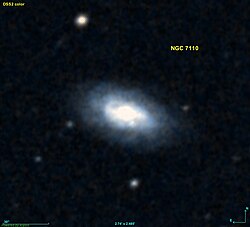NGC 7110
Appearance
| NGC 7110 | |
|---|---|
 The barred spiral galaxy NGC 7110. | |
| Observation data (J2000 epoch) | |
| Constellation | Piscis Austrinus |
| Right ascension | 21h 42m 12.15s[1] |
| Declination | −34° 09′ 44.0″[1] |
| Redshift | 0.017679 [1] |
| Heliocentric radial velocity | 5300 ± 10 km/s[1] |
| Distance | 242.6 ± 17.0 Mly (74.39 ± 5.22 Mpc)[1] |
| Apparent magnitude (V) | 13.2[1] |
| Characteristics | |
| Type | SB(r)b?[1] |
| Size | ~117,300 ly (35.96 kpc) (estimated)[1] |
| Apparent size (V) | 1.3' x 0.6'[1] |
| Other designations | |
| PGC 67199, ESO 403- G 016, MCG -06-47-012, IRAS F21392-3423, 2MASX J21421214-3409436[1] | |
NGC 7110 is a barred spiral galaxy in the constellation of Piscis Austrinus. Its velocity with respect to the cosmic microwave background is 5044 ± 20 km/s, which corresponds to a Hubble distance of 74.39 ± 5.22 Mpc (∼243 million light-years).[1] It was discovered by British astronomer John Herschel on 23 September 1834.[2]
One supernova has been observed in NGC 7110: SN 2023hnl (type Ia, mag. 17.8).[3]
IC 5105 Group
[edit]According to A. M. Garcia, NGC 7110 is part of the IC 5105 group (also known as LGG 445). This group of galaxies contains at least 19 members. The other galaxies in the group are: NGC 7057, NGC 7060, NGC 7072, NGC 7075, NGC 7087, NGC 7130, IC 5105, IC 5105A, IC 5128, IC 5139, and eight galaxies in the ESO catalogue.[4]
See also
[edit]References
[edit]- ^ a b c d e f g h i j k "NASA/IPAC Extragalactic Database". Results for NGC 7110. Retrieved 9 August 2024.
- ^ Seligman, Courtney. "NGC 7110". Celestial Atlas. Retrieved 9 August 2024.
- ^ "Transient Name Server". Entry for SN 2023hnl. Retrieved 9 August 2024.
- ^ Garcia, A. M. (1993). "General study of group membership. II. Determination of nearby groups". Astronomy and Astrophysics Supplement Series. 100: 47. Bibcode:1993A&AS..100...47G.
External links
[edit] Media related to NGC 7110 at Wikimedia Commons
Media related to NGC 7110 at Wikimedia Commons- NGC 7110 on WikiSky: DSS2, SDSS, GALEX, IRAS, Hydrogen α, X-Ray, Astrophoto, Sky Map, Articles and images
